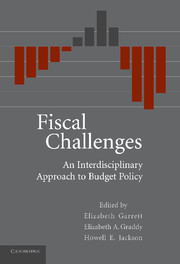Book contents
- Frontmatter
- Contents
- Preface
- Contributors
- PART ONE THE LAW AND POLITICS OF FISCAL POLICY
- 1 The Congressional Budget Process
- 2 Budget Gimmicks
- 3 Transparency in the U.S. Budget Process
- 4 European Experiences with Fiscal Rules and Institutions
- Part One Bibliography
- PART TWO UNDERSTANDING FEDERAL DEFICITS AND PUBLIC DEBT
- PART THREE BUDGETING AND FISCAL CONSTRAINTS AT THE STATE LEVEL
- PART FOUR INTERGOVERNMENTAL ASPECTS OF BUDGET POLICY
- PART FIVE JUDICIAL POWERS AND BUDGET POLICY
- Index
3 - Transparency in the U.S. Budget Process
Published online by Cambridge University Press: 23 December 2009
- Frontmatter
- Contents
- Preface
- Contributors
- PART ONE THE LAW AND POLITICS OF FISCAL POLICY
- 1 The Congressional Budget Process
- 2 Budget Gimmicks
- 3 Transparency in the U.S. Budget Process
- 4 European Experiences with Fiscal Rules and Institutions
- Part One Bibliography
- PART TWO UNDERSTANDING FEDERAL DEFICITS AND PUBLIC DEBT
- PART THREE BUDGETING AND FISCAL CONSTRAINTS AT THE STATE LEVEL
- PART FOUR INTERGOVERNMENTAL ASPECTS OF BUDGET POLICY
- PART FIVE JUDICIAL POWERS AND BUDGET POLICY
- Index
Summary
The notion of “transparency” in government is very much in vogue both in the United States and worldwide, particularly in the arena of fiscal policy. The emphasis on openness is sensible because transparency serves crucial objectives in democracies. Transparency can promote public-spirited behavior by constraining bargaining based on self-interest and promoting principled deliberation instead. Even when self-interest is universal, providing information to principals about the actions of their agents – here, elected officials – reduces the costs of monitoring, thereby promising to improve governance in a representative democracy.
However, the word “transparency” often is used imprecisely to refer to a number of characteristics of an open system without much independent analysis of each aspect. Moreover, adherents of transparency are often insufficiently attentive to the costs of disclosure. Transparency can be in tension with other important democratic values and may even, in some cases, be self-defeating. The unconditional embrace of transparency lies in the power of the word itself – it connotes the opposite of secrecy and skullduggery, putting those who would argue for a tempering of openness in a difficult rhetorical position. This is unfortunate: It diminishes the willingness of many who study transparency to forthrightly consider the costs as well as the benefits.
In this chapter, we propose to focus on one aspect of transparency in the federal budget process: requirements that deliberation and bargaining over budget policy occur publicly. There are several distinct arenas of budget policymaking; currently, each displays a slightly different mix of opacity and transparency.
- Type
- Chapter
- Information
- Fiscal ChallengesAn Interdisciplinary Approach to Budget Policy, pp. 68 - 102Publisher: Cambridge University PressPrint publication year: 2008
- 2
- Cited by



